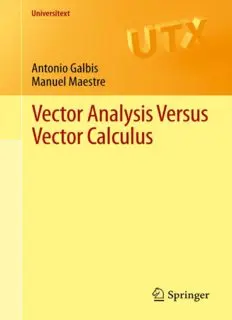
Vector analysis versus vector calculus PDF
Preview Vector analysis versus vector calculus
Universitext Universitext SeriesEditors: SheldonAxler SanFranciscoStateUniversity VincenzoCapasso Universita` degliStudidiMilano CarlesCasacuberta UniversitatdeBarcelona AngusJ.MacIntyre QueenMary,UniversityofLondon KennethRibet UniversityofCalifornia,Berkeley ClaudeSabbah CNRS,E´colePolytechnique EndreSu¨li UniversityofOxford WojborA.Woyczynski CaseWesternReserveUniversity Universitext is a series of textbooksthat presents material from a wide variety of mathematicaldisciplinesatmaster’slevelandbeyond.Thebooks,oftenwellclass- testedbytheirauthor,mayhaveaninformal,personalevenexperimentalapproach to their subject matter. Some of the most successful and established books in the series have evolved through several editions, always following the evolution of teachingcurricula,toverypolishedtexts. Thus as research topics trickle down into graduate-level teaching, first textbooks writtenfornew,cutting-edgecoursesmaymaketheirwayintoUniversitext. Forfurthervolumes: http://www.springer.com/series/223 Antonio Galbis (cid:129) Manuel Maestre Vector Analysis Versus Vector Calculus 123 AntonioGalbis ManuelMaestre Depto.Ana´lisisMatema´tico Depto.Ana´lisisMatema´tico UniversidaddeValencia UniversidaddeValencia Burjasot(Valencia) Burjasot(Valencia) Spain Spain ISSN0172-5939 e-ISSN2191-6675 ISBN978-1-4614-2199-3 e-ISBN978-1-4614-2200-6 DOI10.1007/978-1-4614-2200-6 SpringerNewYorkDordrechtHeidelbergLondon LibraryofCongressControlNumber:2012932088 MathematicsSubjectClassification(2010):58-XX,53-XX,79-XX ©SpringerScience+BusinessMedia,LLC2012 Allrightsreserved.Thisworkmaynotbetranslatedorcopiedinwholeorinpartwithoutthewritten permission of the publisher (Springer Science+Business Media, LLC, 233 Spring Street, New York, NY10013, USA),except forbrief excerpts inconnection with reviews orscholarly analysis. Usein connectionwithanyformofinformationstorageandretrieval,electronicadaptation,computersoftware, orbysimilarordissimilarmethodologynowknownorhereafterdevelopedisforbidden. Theuseinthispublicationoftradenames,trademarks,servicemarks,andsimilarterms,eveniftheyare notidentifiedassuch,isnottobetakenasanexpressionofopinionastowhetherornottheyaresubject toproprietaryrights. Printedonacid-freepaper SpringerispartofSpringerScience+BusinessMedia(www.springer.com) To Beaand Mar´ıa Preface This book aims to be useful. This might appear to be a trivial statement (after all, whatwould the alternativebe?), butlet us explainhow this simple motivation provides us with a rather ambitious goal. The central theme of the book revolves aroundStokes’stheorem,anditdealswiththefollowingassociatedparadox.There are clear intuitive notions coming from the physical world and our own visual geometricinsightthattelluswhataclosedsurfaceis,whattheinteriorandexterior of that surface are, what is meant by a flux across it, what a normal vector to it is, and whether it points in or out—in other words, how to orient that surface. The student of vector calculus is usually provided with a clear and useful set of rulesastohowtoorientasurfaceinapplyingthedivergencetheorem,andhowto orientthe boundaryofa surfacein theclassicalStokes’stheorem.However,when thisstudentundertakesaformalstudyoforientationthroughmathematicalanalysis and/or differential geometry, she or he then realizes that orientation is defined in termsofthetangentspaceateachpointofthesurface,andtheconnectionwiththe practicalrulesofvectorcalculusisfarfromclear.Tomakethingsworse,theusual closed surfaces used in R3, that is, those that are required for practical purposes, haveverticesandedges,themostnaturalexamplebeingthecube,andtheyarenot regularsurfaces. Hence, a student of mathematics, formally at least, cannotapply Stokes’stheoremtomostnaturalsituationsinwhichitisrequired. There is another element that deeply concerned the authors when they were introducedto the subject, and that is the variousnotationalconventions.Actually, the problem is not just with notation. This is a subject that can be approached in manydifferentways,allofwhichareequallyvalid,andeachofwhichhasitsown particular merits. There is undoubtedly an advantage in seeing a topic treated in differentways,butunfortunatelyinthisinstance,itisalltoocommonforastudentto becometrappedwiththeparticularnotationand/orpointofviewusedbyoneauthor onthesubject.Forexample,arecommendedtextbookmaychoosetouseavectorial pointofview,andemployintegralsofdifferentialforms,whileanothermayoptfor scalarintegralsandtheuse,ornot,oftensors.Thereareseveralpossibilitiesforthe definitionofregularsurface,fromtheveryabstractnotionofdifferentialmanifold tothemorefamiliarconceptofdifferentialsubmanifoldofRn,andsoon.Astudent vii viii Preface willfollowoneapproach,whichusesoneofthemoreorlessequivalentdefinitions available,butwhenthestudenttriestoclarifyanobscurepointbystudyinganother good exposition, very frequently the notation is alien, or worse, inconsistent with what the student already knows, so that the only option is to begin from scratch withthealternativeapproach.Mostofthetime,thestudentbecomesfrustratedand simplygivesup. Thisbookisintendedasatextforundergraduatestudentswhohavecompleteda standard introduction to differential and integral calculus of functions of several variables. We have written the book principally having in mind students of mathematicswhoneedapreciseandrigorousexpositionofStokes’stheorem.This hasledustochooseadifferential-geometricpointofview.However,wehavetaken great care to bridge the gap between a formal rigorous approach and a concrete presentationofapplicationsintwoandthreevariables.Weshowhowtousethetools fromvectorcalculusandmodernmethodsthathelptocheck,forexample,whether aparticularsetin R3 isanorientablesurfacewithboundary.Inaless formalway, we show how to apply the obtainedresults on integrationoverregularsurfaces to lessamenable(butmorepractical)situationslikethecube.Wehavelookedatmost ofthedefinitionsofregularsurfaceandshowntheequivalenceofthem.Wediscuss how one definition may be more convenient for solving exercises while another, equivalent,definitionmaybemoresuitableinprovingatheorem.Wehavetriedto includeineachchapterasmanyexamplesandsolvedexercisesaspossible. We havechosenthe pointof viewof k-forms,butin eachpossible instance we switch to employingvectorfields and the classical notationcoming fromphysics. In general, we have made an effort to explain the connection between the usual practical rules from vector calculus and the rigorous theory that is at the core of vector analysis. This means that the book is also addressed to engineering and physics students, who know quite well how to handle the familiar theorems of Green,Stokes’s,andGauss,butwhowouldliketoknowwhytheyaretrueandhow torecoverthesefamiliarusefultoolsinR2 orR3 fromthemightyformalStokes’s theorem in Rn. In summary, we have tried hard to show that vector analysis and vector calculus are not always at odds with one another. Perhaps we should have appendedaquestionmarktothetitle. The book contains some appendices that are not necessary for the rest of the book,butwillofferthestudenttheopportunitytogetmoredeeplyinvolvedinthe subjectathand. While we are in great debt to many authors, including Do Carmo, Edwards, Fleming, Rudin, and Spivak, we do believe that our approach is quite original. However, we do not pretend that originality is our principal motivation. Only to beuseful. Burjasot,Spain AntonioGalbis ManuelMaestre Preface ix Acknowledgments TheauthorsareverygratefultoMichaelMackey(UniversityCollegeDublin)forhis greatassistance inrevisingthetext.We alsowanttothankMichaelforhiscritical reading of the mathematics, giving us many suggestions that have lead to several improvementsofthisbook.
